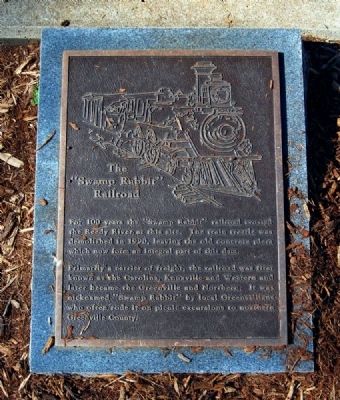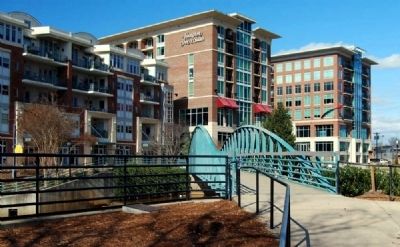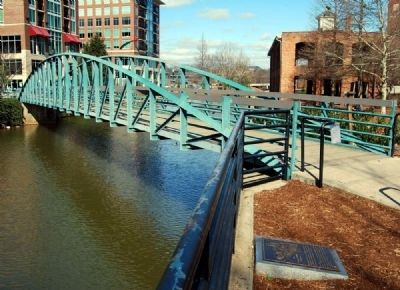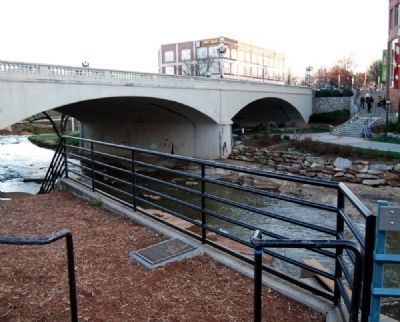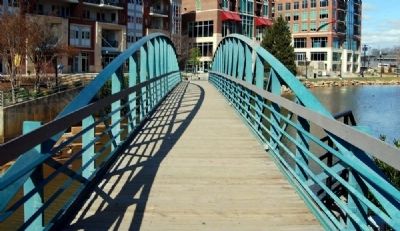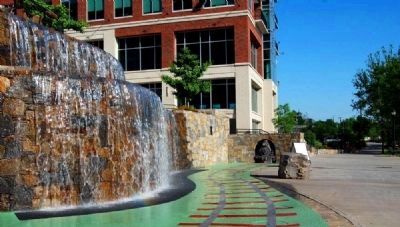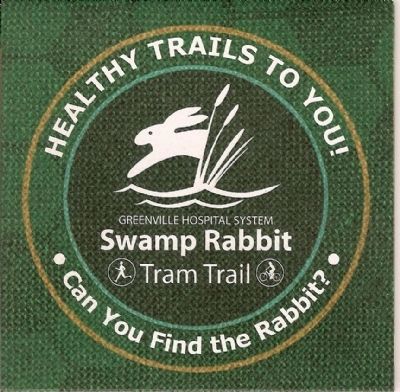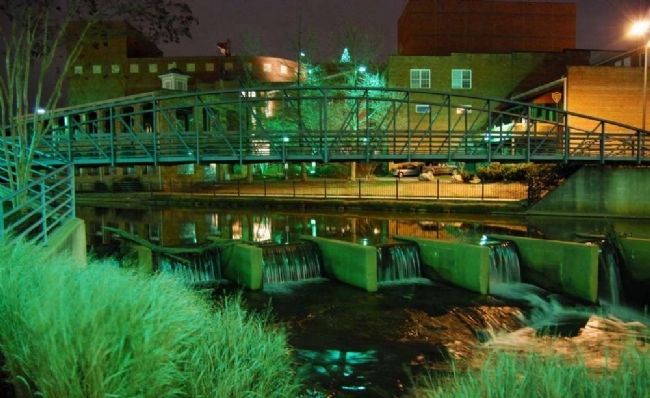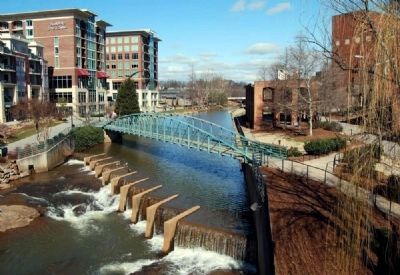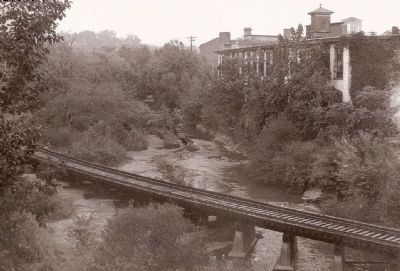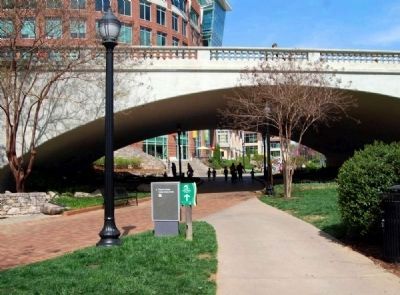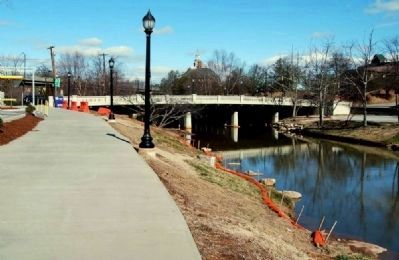Greenville in Greenville County, South Carolina — The American South (South Atlantic)
The "Swamp Rabbit" Railroad
For 100 years the "Swamp Rabbit" railroad crossed the Reedy River at this site. The train trestle was demolished in 1990, leaving the old concrete piers which now form an integral part of this dam.
Primarily a carrier of freight, the railroad was first known as the Carolina, Knoxville and Western and later became the Greenville and Northern. It was nicknamed "Swamp Rabbit" by local Greenvillians who often rode it on picnic excursions to northern Greenville County.
Erected 2009.
Topics. This historical marker is listed in this topic list: Railroads & Streetcars. A significant historical year for this entry is 1990.
Location. 34° 50.767′ N, 82° 24.083′ W. Marker is in Greenville, South Carolina, in Greenville County. Marker can be reached from South Main Street. The marker is located near the eastern end of the pedestrian bridge. Touch for map. Marker is in this post office area: Greenville SC 29601, United States of America. Touch for directions.
Other nearby markers. At least 10 other markers are within walking distance of this marker. About 1765 (a few steps from this marker); Thomas C. Gower Bridge (within shouting distance of this marker); Eugenia Duke Bridge (within shouting distance of this marker); Wyche Pavilion (within shouting distance of this marker); Vardry Dixon Ramseur, III (about 300 feet away, measured in a direct line); Buck Mickel (about 300 feet away); Falls Place (about 300 feet away); Welcome to Falls Park (about 400 feet away); Liberty Bridge (about 400 feet away); Dr. Charles Hard Townes (about 400 feet away). Touch for a list and map of all markers in Greenville.
Also see . . .
1. Chasing the Swamp Rabbit. The Swamp Rabbit Trail is part of the rails to trails movement, and is named for the former Greenville and Northern Railway that used to run from downtown Greenville to River Falls in the Jones Gap area. (Submitted on March 27, 2010, by Brian Scott of Anderson, South Carolina.)
2. GHS Swamp Rabbit Tram Trail Opening. The Greenville Hospital System announced that it would give $1 million in support of the GHS Swamp Rabbit Tram Trail. (Submitted on March 27, 2010, by Brian Scott of Anderson, South Carolina.)
3. Hincapie Path Dedication. The City of Greenville dedicates a portion of the Swamp Rabbit Trail to professional cyclist and Greenville resident, George Hincapie. (Submitted on March 27, 2010, by Brian Scott of Anderson, South Carolina.)
4. Swamp Rabbit Trail. Ever
since I bought a used bike and my wife restored her old one, she’s been bugging me to get out and ride the new Swamp Rabbit Trail extension in Traveler’s Rest, SC. (Submitted on April 30, 2010, by Brian Scott of Anderson, South Carolina.)
Additional commentary.
1. The Swamp Rabbit Railroad
By Charles A. David
The Greenville News
July 18, 1926
You may name your boy Percival, Algernon, or Montmoresst, but it some chap at school dubs him "Sorrel-top," "Bully," or "Buster," the nick-name will stick and his real name forgotten. So it has been with this little railroad--its owners christened it the Carolina, Knoxville and Western, but some fellow with a bit of humor in his make-up spoke of it as "The Swamp Rabbit," and that appropriate name continues to the exclusion of the longer and higher-sounding one.
When the route was surveyed, if it ever was, it was evident that if they followed the swamp bordering the river, that little grading would have to be done, and building the line would be just that much cheaper.
So we find that the railroad hugs the edge of the swamp from its starting point just below the "medder" to its terminal on the south bank of the Saluda, where the money gave out and the road suddenly
stopped, and it gazes sadly across the stream that has never been bridged.
The road as it now stands, and it looks as if it was destined to stand there forever, is only some fifteen miles long--just a trifle longer than its name--its real name, I guess.
The road is now a little more than a right-of-way, and two wavy streaks of rust; but at one time it held hope of great things for Greenville, as it was intended to link this section with the rich coal fields of Tennessee, and we all dreamed dreams and had visions of cheaper coal, and a direct line over the mountains.
But the lack of money and the antagonism of rival interests sounded its death knell, and blasted our hopes. The road started out bravely, with the very best intentions, with head up and tall over the dashboard, planning to cross the mountains on a wonderful grade that had just been discovered, hesitate briefly at Knoxville, and then strike out into the boundless West.
But as it neared the foot of the mountains something happened--funds ran low, the enthusiasm languished, and the bubble that promised so much, burst with a sickening thud, leaving Knoxville and Greenville just as far apart as ever, and coal still sells around then and twelve dollars a ton.
To add to its many troubles, the road got into court, and for years it was bombarded with attachments, injunctions, judgments and the like, and then rival factions took a hand, with the result that at one time the rails were taken up and sold, leaving nothing but the crossties, and most of them rotten.
But by some hook or crook new rails were procured, and once more the road was in a usable condition. One serious trouble with the road was that the name was too long for the length--it was misleading, as no one could understand why a road bearing the name Knoxville and Western should begin and end in the upper part of Greenville County, and people got to looking on the whole thing as a joke. For a while at first daily trains were operated, I should have said train not trains, which came down some time during the morning, and went back to the starting point in the afternoon, and spend the night where it was cool and pleasant.
It never was a train that bothered much about regular hours for leaving and arriving, and a hide-bound schedule was beneath its notice. It left when it got good and ready, and made no rash promises as to when it would arrive.
There was something delightfully informal about this friendly little railroad, and there was a certain element of chance about riding on it that added to the zest of the trip. It did not always stop at the same place, but you could flat it down anywhere simply by holding up your hand, and it would slow down and let you get on. No one could keep from having kindly feeling for anything so obliging, and I came to have something akin to affection for it.
At that time one of my good friends and myself did considerable fishing, though we caught mighty few fish, and Montague, one of the stations, and in the streams about Riverview, so we came to be fairly regular patrons of the road, and the conductor never refused to take us on, or let us off, no matter where we might be.
Most of the rolling stock was second hand, and had been retired on a pension by some other road, and under the varnish of the passenger coach could distinctly be read the legend, "Pennsylvania RR. Co.," showing that it was far from home and friends. I did not know until I became intimate with it that so many things could get the matter with a locomotive as happened to the motive power of the C.K. &W.
Some days it would make the trip without a single break down, and then again, it would have to stop for repairs every few miles. For instance, I remember returning one night from Marietta where I had been to attend the funeral of a friend, and coming down during a heavy rainstorm, the engineer discovered that he had lost the cow-catcher, and he had to back the train a mile or so before he found it in a ditch by the track, where it had come loose and dropped off. Such little things were constantly happening, but no one thought anything of them and took it as a matter of course.
The "Swamp Rabbit," true to its name, did not mind inequalities in its pathway, so the track went up and down, following the lay of the land wherever possible. Lack of funds for the upkeep of the roadbed, light rails, and cheap equipment generally, served to make it one of the roughest I have ever encountered, and before a passenger got to the end of his journey he was considerably shaken up, and found that he owned bones that he did not know he possessed. I have heard that some of the farmer's wives utilized this shaking up, and made the railroad to do their churning. They would take their churn of buttermilk along with them when going to town, and when the whistle blew for Greenville, all they had to do was to take off the top and remove the butter to a plate--churned by the motion of the train. I do not say this was true, but it certainly was possible.
I remember one day that my fishing companion and myself boarded the train in Greenville for a day's outing in the country, and from the time pulled out I noticed that it was running even slower than usual, and I inquired the cause, and the conductor coolly informed us that the car just ahead was loaded with dynamite for Wing's quarry, several miles up the road, and he wanted to get it there with as little jolting as possible. Very reassuring that to the two fishermen sitting there gripping roads in one hand and lunch in the other! But the conductor told us that he had carried up several loads of the stuff and none of it had exploded yet. After that experience we always made it a point to find out what the car in front was loaded with before we bought tickets.
The "Swamp Rabbit" road is still running in a spasmodic kind of way, hauling gravel, cordwood, and an occasional coop of chickens.
They will tell you that they are only running tri-weekly freight, but they do not tell you that it means you come down one week and try to get back the next, but live passengers are barred.
— Submitted March 27, 2010, by Brian Scott of Anderson, South Carolina.
Credits. This page was last revised on November 17, 2020. It was originally submitted on March 27, 2010, by Brian Scott of Anderson, South Carolina. This page has been viewed 5,596 times since then and 202 times this year. Photos: 1, 2, 3. submitted on March 27, 2010, by Brian Scott of Anderson, South Carolina. 4. submitted on April 21, 2010, by Brian Scott of Anderson, South Carolina. 5. submitted on March 27, 2010, by Brian Scott of Anderson, South Carolina. 6. submitted on June 3, 2010, by Brian Scott of Anderson, South Carolina. 7. submitted on March 27, 2010, by Brian Scott of Anderson, South Carolina. 8. submitted on March 31, 2010, by Brian Scott of Anderson, South Carolina. 9. submitted on April 2, 2010, by Brian Scott of Anderson, South Carolina. 10. submitted on March 31, 2010, by Brian Scott of Anderson, South Carolina. 11. submitted on April 30, 2010, by Brian Scott of Anderson, South Carolina. 12. submitted on March 31, 2010, by Brian Scott of Anderson, South Carolina.
